Penang Food – The Clash of Cultural Cuisine
Penang, Malaysia is an excitingly diverse city, crammed with the juxtaposition of locals, expats and travellers, who are usually coming through from Thailand and Singapore. It’s a bit of a teeming metropolis of cultural hybrids, really. Penang is literally the bustling rougher cousin of the Kuala Lumpur which is a little more serious and ‘businessy’. Slightly less developed and considerably cleaner, Penang is, to be a bit cliché, a diamond in the rough.
Strangely though, and what I find particularly interesting, Penang has a strange development story, which seems to give it even more charm. Founded, as a trading post by Captain Francis Light of the East India Company in 1786, Penang accidentally became quite important to British colonialism, which helped develop it as the diverse jungle of culture that you find yourself travelling around today, especially in regards to its delectable delicacies. Let’s rewind a little before taking you on a tasty treat tour of palatable Penang. Captain Light was actually sent by his bosses to take Thailand as a trading port. However, after a romantic little love affair, he eloped to Penang to settle with his love interest, turning that into the trading port instead. This led to the fusion of cultural delights now available from top hotels all the way down to lowly street food hawkers. Basically, if Captain Light had done what he was told, I wouldn’t be able to bring you this beautifully long list of exotic eateries in Penang!
So now the background is covered, let’s start by introducing the delicious delicacies on offer in this multi-cultural hullabaloo! From backpacker budgets to splurging high society jetsetters, Penang has a dining option for you.
Sampling the Street – The Lower Budgets
Penang is perhaps the most famous, second only to Bangkok, for its wealth of street food. As Westerners, we don’t really understand what street food is and we’re a bit closed minded on the whole affair. Food…from the street?! How preposterous! However the preconceptions of dirty dishes and salacious salmonella are very far from the truth.
Street food is a way of life for most Malaysians. You and me might see it as a novelty but to Malaysians, dining at pop-up street restaurants is an everyday occurrence and one that you should certainly not miss, no matter your budget. For thrifty backpackers and wealthy world travellers alike, it gives you an affordable way to sample authentic dishes and truly see the real culture of Penang. The thing is, with high-end restaurants and hotel dining rooms, you don’t really get to see the culture surrounding you, whereas street food allows you to get a real taste of Penang’s life; after all, isn’t that why we travel? Also, you can try eating with your hands, which is far harder and much messier than you can imagine!
But which are the best and what should you eat?
Assam Laksa

Assam Laksa is an extremely famous Penang dish. In fact, it might be the best well known; it’s certainly one that most locals will recommend so I’m definitely adding it to this list. It’s a spicy noodley soup with tastebud-tickling sour undertones. So, the traditional dish is kind of a thick broth whereas the Penang version is thinner. It’s poached mackerel that stews in the broth with tamarind, lemongrass, chillies and shrimp paste. This is topped with a big dollop of rice vermicelli. It’s been ranked 7th of the best 100 foods in the world so it’s definitely unmissable.
As I said, it’s super famous so you can find it lurking on pretty much any street in Penang. However, Ayer Itam Pasar is said to serve the best Assam Laksa in the whole world. That’s a pretty big claim so it’s worth testing it out.
Mee Goreng
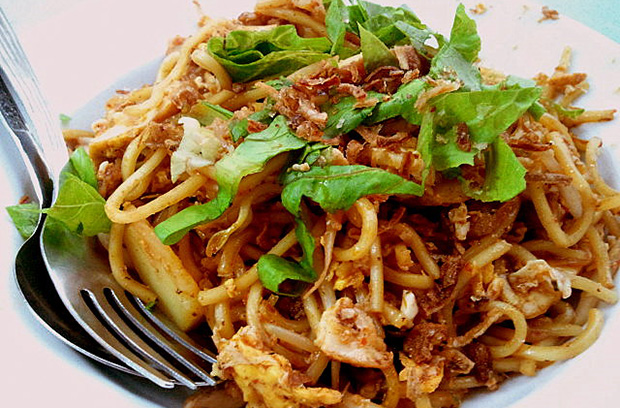
Are you a fan of noodles? If you are, this is one of the juiciest noodly treats in Malaysia. It’s actually quite common in Indonesia and Singapore too, but it’s definitely a must-try while you’re skulking around Penang with a grumbling tummy. It’s made of thin yellow noodles that are all fried up together with garlic, onions, and shallots, with some type of meat, usually prawns or chicken mixed in. It’s also got chilli, egg, cabbage, Chinese cabbage, and pickles in the mix as well to give a variety of different textures and tastes to tickle those taste buds. It basically comes from Chinese chow mein and has evolved into its own Malay dish.
However, I must tell you to visit either Bangkok Lane Mee Goreng stall or Hameed Pata Mee Goreng in Padang Kota Lama. The reason is that both of these little food joints add a kind of Asian sticky red gravy to the mix which gives a spicy/sweet/sour kick to this delicious dish.
Char Kway Teow

Ok, another noodle delight for you. This one is usually served with prawns so it’s a little more of a seafood delight. Its literal translation is ‘stir-fried rice-cake strips’ and that refers to the big fat, flat noodles that it comes with. Although recipes vary from street vendor to street vendor, the general consensus is that this more sloppy noodle dish contains prawns, cockles, beansprouts, Chinese chives, flat rice noodles, egg, soy sauce, chilli, belachan, all fried up in pork lard. This is a bit of a comfort food dish and is high in fat, pretty much due to the pork lard. However, its unhealthiness is mostly weighed out by how tasty it is!
If you’re looking for a real tasty version of this dish, try Ah Leng Char Kuay Teow at Kafe Khoon Hiang. The stall only opens at night but it’s worth the visit as they use duck eggs, which give a creamier flavour.
Hokkien Hae Mee
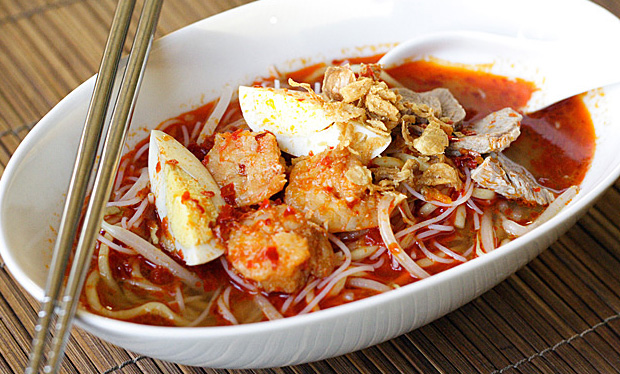
Another delight from under the sea, Hokkien Hae Mee, is a fried noodley prawn dish which is simply delicious. This is one of those street food specials you’ll hear backpackers and locals raving about and you’ll find it recommended on travel blogs all over the worldwide web. And there is good reason. It kind of a soup-based noodle dish that combines prawns, slices of chicken, squid and fish cake, and water spinach. It was actually brought over the Malaysia from Fujian, China.
This dish is really common so you’ll be able to find it everywhere. It’s pretty uniform so it’s hard to get it wrong, which means it’s delicious wherever you can get your mouth round it. 888 Hokkien Mee at Presgrave Street Hawker Centre is a locally-recommended stall to try this delectable food.
Laksa Lemak
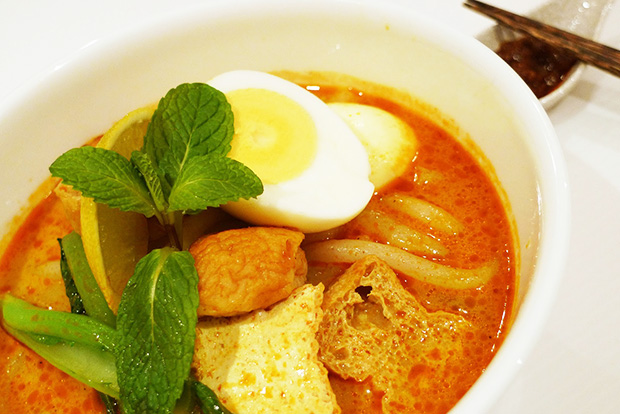
When you’re tempted by a little fine dining, Laksa Lemak is always a good choice in high end restaurants as you’ll find it made with the freshest ingredients and often with interesting twists. It’s a spicy noodle soup dish, which has a slight undertone of curry flavours. This particular Laksa has a sweet coconut milk which is heavily spiced, mixed with a fish gravy. It usually has shrimp or fish sticks in and comes with a chilli paste and coriander.
I’d definitely recommend Living Room Cafe Bar & Gallery as a place to grab a taste of Laksa Lemak. It’s a fusion restaurant so the food has a slightly Western feel to it, but the atmosphere is intimate and quirky with an outdoor feel.
Wanton Mee
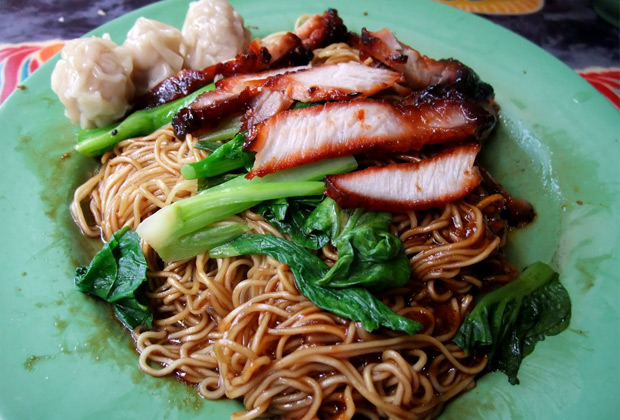 Wanton mee is a very famous noodles dish in Penang. In Chinese “wanton” means dumpling and “mee” is translated as noodles. This dish is usually served in a hot broth and is garnished with leafy vegetables, prawns, chicken or pork, pickled green chilies, spring onions and sometimes mushrooms and black fungus. It can be served dry dressed with oyster sauce. The above version is general, as each state in Malaysia has its own version. In Penang wanton mee is served with black sauce with yummy noodles topped with meat and sauce. This is my favorite dish when I am running out of time.
Wanton mee is a very famous noodles dish in Penang. In Chinese “wanton” means dumpling and “mee” is translated as noodles. This dish is usually served in a hot broth and is garnished with leafy vegetables, prawns, chicken or pork, pickled green chilies, spring onions and sometimes mushrooms and black fungus. It can be served dry dressed with oyster sauce. The above version is general, as each state in Malaysia has its own version. In Penang wanton mee is served with black sauce with yummy noodles topped with meat and sauce. This is my favorite dish when I am running out of time.
There is a night place that offers very delicious wanton mee – Chulia St. Night Hawker Stalls – an amalgam of Chinese restaurants and food trucks.
Nasi Lemak

There is one very famous rice dish that can be served as breakfast, lunch or dinner. I can’t recommend Nasi Lemak as a snack, because this dish has a very high importance for me. The fragrant rice is cooked in coconut milk and carefully arranged on the plate or on the banana/pandan leaf in order to steal its special natural aroma. Sambal, anchovies, peanuts and hard-boiled egg are other mandatory ingredients. I had a chance to eat vegetarian version with vegetarian mock anchovies, and I was equally very pleased of its usual non-vegetarian taste.
Personally I enjoy this dish at the Ali Nasi Lemak stall as Ali always offer fresh and warm portions and the price is very cheap. It offers five different kind of nasi lemak for each taste: fried anchovies and egg, prawn, chicken, cutter fish and plain. The final product is wisely wrapped in banana leaf.
Roti Canai
 Roti canai is an adopted Malaysian flatbread, originally from India. It is also known as roti prata in Southern Malaysia and kerala porotta in India. Roti means bread in many Asian languages, and canai is a derived term from Chennai – an Indian city. This flat bread that is also called flying bread can have circled or square shapes. When I was little my mother would always buy me a piece of simple roti canai, without curry sauce, for breakfast or supper. A little bit of sugar on top of it and it was the most delicious breakfast, sweet or cake – a very important item for my childhood.
Roti canai is an adopted Malaysian flatbread, originally from India. It is also known as roti prata in Southern Malaysia and kerala porotta in India. Roti means bread in many Asian languages, and canai is a derived term from Chennai – an Indian city. This flat bread that is also called flying bread can have circled or square shapes. When I was little my mother would always buy me a piece of simple roti canai, without curry sauce, for breakfast or supper. A little bit of sugar on top of it and it was the most delicious breakfast, sweet or cake – a very important item for my childhood.
I took a drive to Transfer Road in order to eat Roti Canai. I must say that waiting behind 50 people was totally worth their original plain, with egg and banjir roti canai. They always have the tarik – the pulled milk tea with froth.
Char Koay Kak
 Char Koay Kak is translated as carrot cake. It is so delicious and Malays are so proud of it that they serve it even in some clothing stores that I visited. I have noticed that Penang has a special version of Char Koay Kak. Carrot cake, locally known as kway kak is made from white radish and rice flour. It is made from stir-fried carrot cake pieces, salted turnips, bean sprouts, eggs, dark soy sauce, a little chili paste and lard.
Char Koay Kak is translated as carrot cake. It is so delicious and Malays are so proud of it that they serve it even in some clothing stores that I visited. I have noticed that Penang has a special version of Char Koay Kak. Carrot cake, locally known as kway kak is made from white radish and rice flour. It is made from stir-fried carrot cake pieces, salted turnips, bean sprouts, eggs, dark soy sauce, a little chili paste and lard.
Each time I visited Burma Road for another portion of Char Koay Kak I had to wait a while, but I know that this dish takes time to be cooked and my time is nothing comparing to their original, delicious and very aromatic Char Koay Kak. A small portion was RM3.00 and a big one RM4.50 – fair enough for its mouthwatering taste.
Oh Chien

As I said before, Penang is a melting pot of cultures and Chinese food has seeped into the everyday food that’s sold all over Penang. Oh Chien is a Chinese omelette dish made from tapioca flour. Basically, it’s mouth-watering. Aside from the omelette itself and the oysters, it’s got garlic, a little chilli paste, some shallots and eggs in it; all fried up and greasy to go!
One of the places I’d recommend for Oh Chien isn’t really a stall as such, but is more of a small low-budget hole-in-the-wall cafe called Kedai Kopi Seng Thor. You can find it on Lebuh Carnarvon; it’s right around the corner from where you’ll be sampling Hokkien Hae Mee!
Popiah
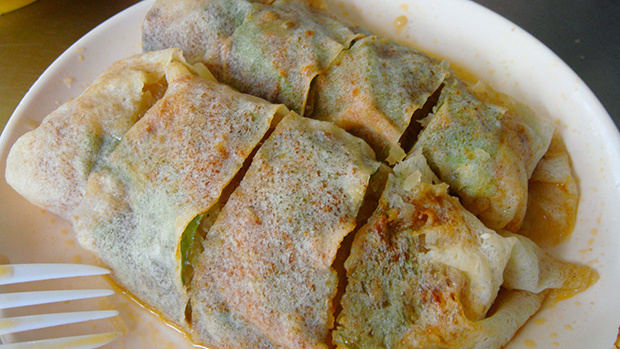
When it comes to Asian food, we’ve all got stereotypes and I think spring rolls are pretty much ingrained as typically Asian for anyone from the western world. Unwilling to disappoint, Penang has its own spring rolls called Popiah which are definitely worth experiencing. They’re made from little porous crepes which soak up all the yummy sweet/savoury juices. It’s made of soybean curd, eggs, vegetable stew and Chinese lettuce, all wrapped up and dipped in sweet sauce, chilli sauce and black sauce. It’s crispy and saucy and yummy!
Famously, Popiah is dished up at Stall 17 of Padang Brown Hawker Centre. You get all the sauces to choose from so you can sample this delight with all the trimmings.
Pasembur
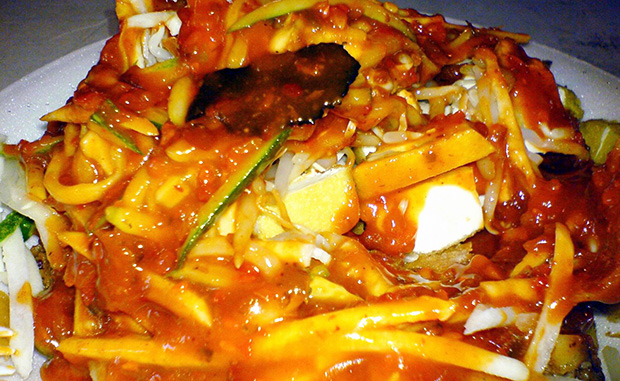
It may seem strange to begin with a salad but that’s the first dish I’m going to highly recommend to you. Pasembur is a Malaysian-Indian salad that’s basically a mess of cucumber, beancurd, potatoes, fried octopus, fried crab, turnip, bean sprouts and prawn fritters, dressed in a nutty-spicy sauce. A combo of under-the-sea delights and fresh crisp vegetables, this dish is not only a healthy, scrumptious sweet/sour delight.
Where can you get it? The best and most well known place is probably Gurney Drive Hawker Centre, which is located next to Gurney Plaza and offers a drove of street food stalls that truly represent the cultural menagerie of food offered in Penang. Street food stalls include Indian, Malay, Mamak, and Chinese cuisine, which gives you the opportunity to sample some of the best cooks without having to traipse aimlessly around the city. With all the choice they offer, definitely don’t forget to get your lips around some pasembur!
Chee Cheong Fun
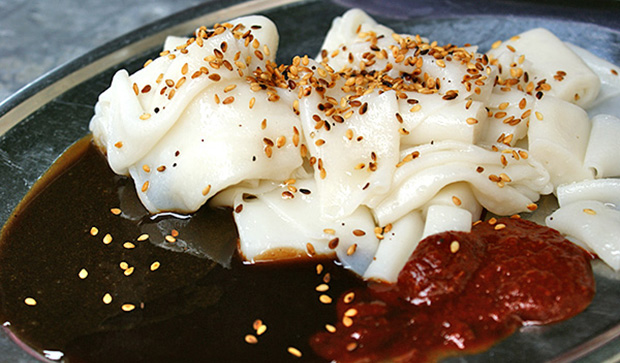
Now, Chee Cheong Fun has a direct Cantonese translation which can be slightly off-putting for the weaker stomachs. It means: ‘pig intestine noodles’. However, no pig intestines are actually found in the dish. Phew! It’s called this because it’s made from rolled up flat rice noodles that resemble pig intestines. I would probably have found a more enticing name if I invented this concoction! Although that may sound a little bland, the flavour comes from the combo of three sauces blended on top of the noodles: prawn paste, chilli sauce, and a dark red sweet sauce. Honestly, the amalgamation of these three flavours is an explosion of taste in your mouth.
If you want to try this dish, it’s more of a light snack. You need to head over to Seow Fong Lye Cafe where you’ll find a stall outside. Usually it’s an accompaniment, so if you’re hungry, try a few other dishes too.
Penang Rojak
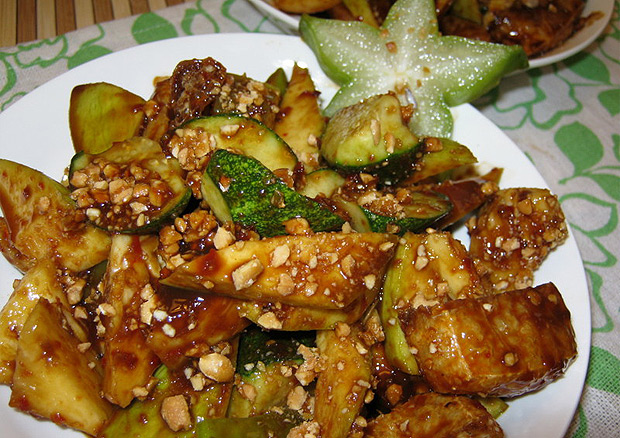
Rojak is a traditional Asian fruit and vegetable salad. It can be found in Indonesia, Singapore and Malaysia. The term “rojak” means mixture in Malay. Penang Rojak is a typical salad that is similar to a fruit one – cucumber, pineapple, cuttlefish, turnip, but has some other ingredients: jambu air, guava, squid fritters, honey and sometimes raw mangoes and green apples. This dish has no bean sprouts and fried tofu puffs. What’s most delightful is the very thick prawn sauce.
One of the popular places to eat this local delicates is Hock Seng Rojak (or Rojak king) – and I assure you its name says it all. The lady chef is very friendly and she will love to cook your fresh rojak instantly.
Cendol

Cendol is a traditional Southern Asian dessert. You can order it in a plate or in a cup. When I am in a hurry I drink it, but when I have plenty of time I enjoy each spoon. Its basic ingredients are coconut milk, jelly noodles, shaved ice and palm sugar. In Penang, this mouthwatering dish also includes red beans, glutinous rice, grass jelly and creamed corn. Despite the fact that this dessert is so sweet and delicious it is also nutritional and healthy. It is suitable for everyone as the ingredients balance makes it not too sweet for diabetics or for children.
I must tell you that Teo Chew Cendol is super famous and offers the best Cendol in Penang for many years and is still the best. The price is only RM1.50, but the original taste will remain forever in your mouth.
Ice Kacang

Ice Kacang is a typical Malaysian dessert, but it can also be found in Brunei and Singapore. This dish is not easy to prepare at home as a special ice machine is needed to churn out the shaved ice. As Air Batu Campur means mixed ice, this dessert is also known as ABC. I found it very interesting that today ice kacang brings colors as initially it was made of only shaved ice and red beans. Palm seed, sweet corn, grass jelly and cubes of agar agar are other important ingredients of Penang’s ice kacang. The coconut milk topping makes this dish mouthwatering.
Ice kacang can be found everywhere at coffee shops, hawker centres, food court and even restaurant offers it! But my favorite place for this dessert is the typical old style Malaysian restaurant – Kek Seng Café. Their secret is serving Ice Kacang with yummy durian ice-cream.
Tau Sar Peah
 Penang Tau Sar Peah is a delicious and original bean biscuit. The tau sar refers to the red bean paste found in this food. Red beans become mushy as they are cooked with sugar. There are some different varieties of tau sar biscuits on the market, such as mung bean or lek tau and lotus bean paste. Tau sar peah is made from the same core ingredients as tambun peah; the two differ only in shape. It is best to eat this biscuits fresh and still warm out of the oven. I usually pre-order before my Penang arrival and I assure you this is the best way to eat traditional Penang tau sar biscuits.
Penang Tau Sar Peah is a delicious and original bean biscuit. The tau sar refers to the red bean paste found in this food. Red beans become mushy as they are cooked with sugar. There are some different varieties of tau sar biscuits on the market, such as mung bean or lek tau and lotus bean paste. Tau sar peah is made from the same core ingredients as tambun peah; the two differ only in shape. It is best to eat this biscuits fresh and still warm out of the oven. I usually pre-order before my Penang arrival and I assure you this is the best way to eat traditional Penang tau sar biscuits.
Ghee Hiang, Him Heang, Hoe Peng, Lee Hoay Seng, Loong Num, Sin Hock Seng and Xiang Phing Bakery are a few well known places that offer fresh and the most delicious Penang tau sar biscuits.
Experiencing the Elite – The Higher Budgets
When sampling the cuisine of Penang, most traditional dishes can be found at street stalls, but I find it’s sometimes nice to treat yourself to a little fine dining. The thing is with Penang, because the culture is so diverse, fine dining usually becomes somewhat of a ‘fusion’ experience, which is most definitely a bonus in my eyes.
Here are my 2 fine dining picks:
Prawn Malai Curry

As mentioned before, Malay food is usually quite curry based due to the influence of Indian food, or noodle based due to its Chinese ancestors. The Indian food is a must-try with its mouth-watering warmness and tongue-tingling spices. Frankly, I love a good curry, especially when it’s been inspired by Southern Indian cuisine. Prawn Malai Curry is exactly that. It’s a delightfully sloppy dish made up mainly of a cashew nut and coconut milk sauce, richly scattered with shrimp. It seems to combine that lovely crispness you get with seafood and the kind of comfort food feel of curry.
The best Prawn Malai Curry, in my eyes, is from Karaikudi Restaurant. Most of the food is Malay/Indian fusion, drawing on old recipes, yet the restaurant itself has quite an intoxicatingly modern feel.
Udang Galah Redang

Udang Galah means giant freshwater shrimp. That’s the main source of excitement with this dish as the shrimp served up here are enormous! The dish itself comprises of shrimp cooked in a paste which sometimes turns into a coconut-y curry when coconut milk is added. It’s tangy from the lemongrass and ginger, with undertones of deep turmeric and sweet palm sugar. There are always plenty of chillies to give it a kick and shallots from the complementary crunch. This is one of my Malay favourites.
If you want to try this tasty delight, it’s mainly only served in restaurants. It makes sense to try it in House of Udang Galah as it’s their speciality! Here they pride themselves on the fact that you’re served from fresh livestock which makes it feel all the more exciting and gourmet!
ReplyDeleteNice Blog. Thanks for sharing information. Best Lunch in Penang